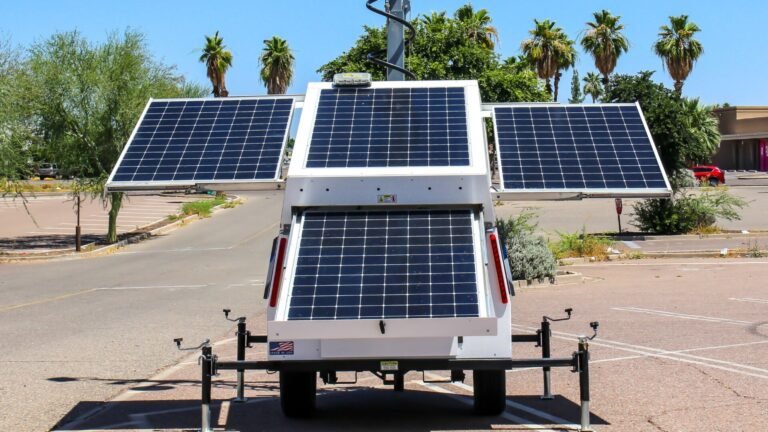As the world grapples with the pressing need for sustainable energy solutions, the solar industry continues to evolve at a remarkable pace.
The year 2025 promises significant advancements in solar technology, offering innovative solutions that can drive global energy transformation.
These advancements are not just about improving efficiency but also about making solar energy more accessible and affordable for everyone.
In this blog, we will explore the emerging solar technologies set to make waves in 2025, highlighting their potential to revolutionize the renewable energy landscape and contribute to a more sustainable future.
From new materials to groundbreaking applications, the solar industry is on the cusp of a transformative era.
1. Perovskite Solar Cells: A Game Changer
One of the most promising emerging solar technologies is the development of perovskite solar cells. These cells have garnered attention due to their high efficiency and low production costs.
Perovskite materials have the potential to surpass traditional silicon-based solar cells in efficiency, making them a game-changer in the solar industry.
Researchers are continually improving the stability and scalability of perovskite solar cells, with recent advancements pushing their efficiency close to 30%.
The versatility of perovskite materials allows for flexible and lightweight solar cells that can be integrated into various applications, from rooftop installations to portable solar chargers.
By 2025, we can expect to see commercial-grade perovskite solar cells entering the market, offering a more affordable and efficient alternative for harnessing solar energy.
Their potential to be manufactured using low-cost printing techniques could revolutionize the production process, making solar power accessible to a broader audience.
2. Bifacial Solar Panels: Harnessing More Power
Bifacial solar panels are another emerging solar technology gaining traction. Unlike traditional solar panels that only capture sunlight from one side, bifacial panels can absorb light from both sides, significantly increasing energy production.
This technology is particularly effective in environments with high albedo surfaces, such as snow-covered or sandy areas.
The ability to capture reflected sunlight enhances the overall efficiency of bifacial solar panels, making them an attractive option for large-scale solar installations.
Moreover, the durability of bifacial panels contributes to their longevity, reducing maintenance costs over time.
As this technology matures, we can anticipate widespread adoption in solar farms and commercial projects by 2025.
Innovations in mounting systems and tracking technology will further optimize their performance, ensuring maximum energy yield from every installation.
3. Floating Solar Farms: Maximizing Space and Efficiency
Floating solar farms, also known as floatovoltaics, represent an innovative solution to the challenge of limited land availability for solar installations.
By placing solar panels on bodies of water, such as reservoirs and lakes, this technology maximizes space utilization and improves energy efficiency.
Floating solar farms benefit from the cooling effect of water, which enhances the performance and longevity of solar panels.
Additionally, they reduce water evaporation and algae growth, providing environmental benefits. The installation process of floating solar farms is relatively straightforward and can be deployed in various water bodies, from small ponds to large hydroelectric dams.
With advancements in floating solar technology, we can expect to see an increase in deployment across the globe by 2025.
This innovative approach not only optimizes land use but also paves the way for hybrid energy systems combining solar and hydropower.
4. Solar Skins: Integrating Aesthetics and Functionality
Solar skins are an emerging solar technology that combines aesthetics with functionality. These customizable photovoltaic panels can be designed to match the appearance of traditional building materials, such as roofing shingles or facades, without compromising energy production.
Solar skins offer a seamless integration of solar technology into residential and commercial buildings, promoting wider adoption of solar energy.
By 2025, we can anticipate more aesthetically pleasing and efficient solar skin products entering the market, catering to the growing demand for sustainable and visually appealing solutions.
The versatility of solar skins allows architects and designers to incorporate renewable energy into their projects without sacrificing aesthetic appeal, thus overcoming a significant barrier to the adoption of solar technology in urban environments.
5. Transparent Solar Panels: Powering the Future
Transparent solar panels are poised to revolutionize the way we harness solar energy in urban environments.
These panels can be integrated into windows, skylights, and other transparent surfaces, generating electricity without obstructing natural light.
The potential applications of transparent solar panels are vast, ranging from office buildings to greenhouses.
As research and development progress, we can expect to see increased efficiency and affordability of transparent solar panels, making them a viable option for sustainable urban development by 2025.
The integration of transparent solar panels into everyday infrastructure can lead to the creation of self-sustaining buildings, significantly reducing their reliance on external energy sources and contributing to the overall goal of carbon neutrality in urban areas.
6. Solar-Powered Hydrogen Production: The Next Frontier
Solar-powered hydrogen production is an emerging solar technology with the potential to transform the energy landscape.
By using solar energy to split water molecules, hydrogen can be produced as a clean and renewable fuel source.
This technology addresses the intermittency of solar power by providing a method for storing and transporting energy.
With ongoing advancements in solar-powered electrolysis, we can expect to see significant strides in hydrogen production and utilization by 2025, paving the way for a hydrogen-based economy.
The integration of solar-powered hydrogen production into existing energy systems can provide a stable and sustainable energy supply, reducing dependency on fossil fuels and promoting the adoption of renewable energy on a larger scale.
7. Agrivoltaics: Dual-Use Solar Solutions
Agrivoltaics, or the co-location of solar panels and agricultural activities, is an emerging solar technology that offers dual benefits.
By installing solar panels above crops or grazing areas, agrivoltaics optimize land use, providing renewable energy while supporting agricultural productivity.
This technology can enhance crop growth by providing shade and reducing water evaporation, creating a symbiotic relationship between energy production and agriculture.
Agrivoltaic systems can be tailored to different types of crops and farming practices, ensuring minimal disruption to agricultural activities.
As agrivoltaic systems continue to evolve, we can anticipate their broader adoption in rural and agricultural areas by 2025, offering a sustainable solution to the challenges of food and energy production.
8. Solar Fabrics: Weaving Energy into Everyday Life
Solar fabrics are an innovative approach to integrating solar technology into everyday objects.
These flexible and lightweight fabrics can be embedded with photovoltaic cells, enabling them to generate electricity from sunlight.
The potential applications of solar fabrics are vast, ranging from clothing to tents and backpacks. As research advances, we can expect to see more efficient and durable solar fabrics on the market by 2025, providing new opportunities for portable and wearable solar energy solutions.
The development of solar fabrics can revolutionize the way we think about energy generation, making it possible to harness solar power on the go and in remote locations, where traditional solar installations might not be feasible.
Conclusion: Embracing the Future of Solar Energy
The rapid advancements in emerging solar technologies promise a brighter and more sustainable future. From perovskite solar cells to solar fabrics, these innovations are set to revolutionize the way we harness and utilize solar energy.
As we look towards 2025, the adoption of these technologies will play a crucial role in addressing global energy challenges and reducing our carbon footprint.
The integration of these cutting-edge technologies into existing and new infrastructures will not only enhance energy efficiency but also create new opportunities for economic growth and job creation within the renewable energy sector.
At Tamesol, we are committed to staying at the forefront of solar innovation. Our dedication to integrating emerging solar technologies ensures that we provide our clients with the most efficient and sustainable solutions available.
By continually investing in research and development, we strive to deliver state-of-the-art products that meet the evolving needs of our customers and contribute to a sustainable future.
Together, we can embrace the future of solar energy and drive the transition to a cleaner, greener world, fostering a legacy of sustainability for generations to come.






